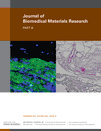Controlled release niosome embedded chitosan system: Effect of crosslink mesh dimensions on drug release†
How to cite this article: Williams EC, Toomey R, Alcantar N. 2012. Controlled release niosome embedded chitosan system: Effect of crosslink mesh dimensions on drug release. J Biomed Mater Res Part A 2012:100A:3296–3303.
Abstract
We report on a model chemotherapy drug delivery system comprising nonionic surfactant vesicles (niosomes) packaged within a temperature-sensitive chitosan network. This smart packaging, or package-within-a package system, provides two distinct advantages. First, the gel prevents circulation of the niosomes and maintains delivery in the vicinity of a tumor. Second, the chitosan network protects the niosomes against fluctuations in tonicity, which affects delivery rates. Tonicity is the sum of the concentrations of the solutes which have the capacity to exert an osmotic force across the membrane. All release rate experiments were conducted with 5,6-carboxyfluorescein, a fluorescent dye. Release rates were monitored from both bare niosomes alone and niosome-embedded, chitosan networks. It was observed that chitosan networks prolonged delivery from 100 h to 55 days in low ionic strength environment and pH conditions similar to a tumor site. The primary effect of chitosan is to add control on release time and dosage, and stabilize the niosomes through a high ionic strength surrounding that prevents uncontrolled bursting of the niosomes. Secondary factors include crosslink density of the chitosan network, molecular weight of the individual chitosan polymers, dye concentration within the niosomes, and the number density of niosomes packaged within the chitosan network. Each of these factors can be altered to fine-tune release rates. © 2012 Wiley Periodicals, Inc. J Biomed Mater Res Part A 100A:3296–3303, 2012.




